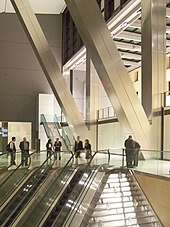Hearst Tower (Manhattan)
The Hearst Tower is a building with the addresses of 300 West 57th Street or 959 Eighth Avenue,[2] near Columbus Circle, in Midtown Manhattan neighborhood of Manhattan in New York City. It is the world headquarters of Hearst Communications, housing most of the numerous publications and communications companies of the media conglomerate under one roof, including, among others, Cosmopolitan, Esquire, Marie Claire, Harper's Bazaar, Good Housekeeping, and Seventeen.
| Hearst Tower | |
|---|---|
Hearst Tower in 2006 | |
%26groups%3D_3f2edc2a534c00c110219a60d085b6ab6a87ec84.svg)
| |
| General information | |
| Status | Complete |
| Type | Office |
| Architectural style | Structural expressionism |
| Location | 300 West 57th Street or 959 Eighth Avenue, near Columbus Circle, Midtown Manhattan, Manhattan, New York City, New York 10019 United States |
| Coordinates | 40.766538°N 73.983452°W |
| Construction started | April 30, 2003 |
| Completed | 2006 |
| Opening | 2006 |
| Cost | $500 million ($6250/office sq.m.)[1] |
| Height | |
| Roof | 182 m (597 ft) |
| Technical details | |
| Floor count | 46 |
| Floor area | 80,000 square metres (861,100 sq ft) |
| Lifts/elevators | 15 |
| Design and construction | |
| Architect | Norman Foster Foster + Partners Adamson Associates Architects |
| Developer | Tishman Speyer |
| Structural engineer | WSP Cantor Seinuk |
| Main contractor | Turner Construction |
| Awards and prizes | International Highrise Award 2008 |
History
_002.jpg)
The six-story base of the headquarters building was commissioned by the founder, William Randolph Hearst, and awarded to the architect Joseph Urban. The building was completed in 1928[3] at a cost of $2 million and contained 40,000 sq ft (3,700 m2). The original cast stone facade has been preserved in the new design as a designated Landmark site. Originally built as the base for a proposed skyscraper, the construction of the tower was postponed due to the Great Depression. The new tower addition was completed nearly eighty years later, and 2,000 Hearst employees moved in on June 26, 2006.[4]
Architecture and design
The tower—designed by the architect Norman Foster, structurally engineered by WSP Cantor Seinuk, and constructed by Turner Construction—is 46 stories tall, standing 597 feet (182 m) with 80,000 square metres (860,000 sq ft) of office space. The uncommon triangular framing pattern (also known as a diagrid) required 9,500 metric tons (10,480 tons) of structural steel—reportedly about 20% less than a conventional steel frame. Hearst Tower was the first skyscraper to break ground in New York City after September 11, 2001. The building received the 2006 Emporis Skyscraper Award,[5] citing it as the best skyscraper in the world completed that year.
Hearst Tower is the first "green" high-rise office building completed in New York City, with a number of environmental considerations built into the plan. The floor of the atrium is paved with heat conductive limestone. Polyethylene tubing is embedded under the floor and filled with circulating water for cooling in the summer and heating in the winter. Rain collected on the roof is stored in a tank in the basement for use in the cooling system, to irrigate plants and for the water sculpture in the main lobby. 85% of the building's structural steel contains recycled material. Overall, the building has been designed to use 26% less energy than the minimum requirements for the city of New York, and earned a gold designation from the United States Green Building Council’s LEED certification program, becoming New York City's first LEED Gold skyscraper.
The atrium features escalators which run through a 3-story water sculpture titled Icefall, a wide waterfall built with thousands of glass panels, which cools and humidifies the lobby air. The water element is complemented by a 70-foot-tall (21 m) fresco painting titled Riverlines by artist Richard Long.
Window cleaning

The facade of the Hearst Tower is jagged. Plans for a rig, designed by Tractel-Swingstage, to hold window cleaners, took 3 years and $3 million because of the concave window structures at the building's corners, referred to as "bird's mouths".[6] The resulting design incorporates "a rectangular steel box the size of a Smart car, supporting a 40-foot mast and hydraulic boom arm attached by six strands of wire rope to a telescopic cleaning basket, [and housing] a computer that monitors 67 electromechanical safety sensors and switches".[7] The device was installed in April 2005 on 420 feet (130 m) of elevated steel track looping the roof of the tower.[7]
On June 12, 2013, two window cleaners were trapped on the window cleaning crane partway down from the top of the tower.[8]
See also
References
Notes
- "Hearst Tower". Newyork.construction.com. Retrieved June 10, 2014.
- "How Green Is My Tower?". The New York Times. April 16, 2006. Retrieved July 9, 2016.
- "Hearst Tower History". Archived from the original on May 5, 2012. Retrieved October 13, 2012.
- New York Post Archived June 13, 2006, at the Wayback Machine
- "Emporis Awards". Emporis. Archived from the original on July 10, 2011. Retrieved January 17, 2007.
- Sara Polsky (January 28, 2013). "Six Facts About Cleaning New York City Skyscraper Windows - Look, Up in the Sky!". Curbed. Retrieved June 10, 2014.
- Pearce, Matt (June 12, 2013). "Window washers stranded 45 stories high in Manhattan are rescued". The Los Angeles Times. Retrieved June 13, 2013.
- "Hearst Tower Was a Scene of Nightmares as Window Washers Held in the Sky". The Atlantic. June 12, 2013. Retrieved June 23, 2018.
Further reading
- Up to the Sky: Hearst Tower, New York. Documentary by Sabine Pollmeier and Joachim Haupt. 2009.
- Hearst Tower Documentary produced by Treasures of New York
- Stichweh, Dirk. New York Skyscrapers. Prestel Publishing, Munich 2009, ISBN 3-7913-4054-9.
- Luxis: Hearst Tower New York, NY
External links
| Wikimedia Commons has media related to Hearst Tower (Manhattan). |
